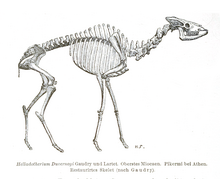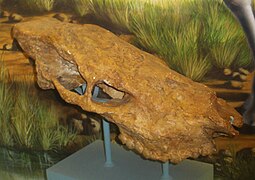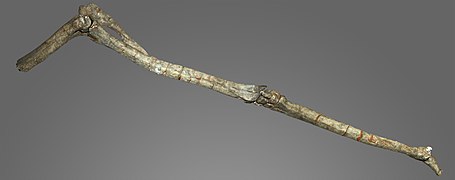
Felidae is the family of mammals in the order Carnivora colloquially referred to as cats. A member of this family is also called a felid. The term "cat" refers both to felids in general and specifically to the domestic cat.
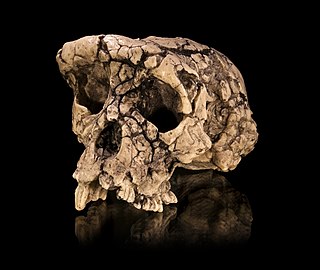
Sahelanthropus tchadensis is an extinct species of the hominid dated to about 7 million years ago, during the Miocene epoch. The species, and its genus Sahelanthropus, was announced in 2002, based mainly on a partial cranium, nicknamed Toumaï, discovered in northern Chad.

The order Peramelemorphia includes the bandicoots and bilbies. All members of the order are endemic to Australia-New Guinea and most have the characteristic bandicoot shape: a plump, arch-backed body with a long, delicately tapering snout, very large upright ears, relatively long, thin legs, and a thin tail. Their size varies from about 140 grams up to 4 kilograms, but most species are about one kilogram.

The Giraffidae are a family of ruminant artiodactyl mammals that share a common ancestor with deer and bovids. This family, once a diverse group spread throughout Eurasia and Africa, presently comprises only two extant genera, the giraffe and the okapi. Both are confined to sub-Saharan Africa: the giraffe to the open savannas, and the okapi to the dense rainforest of the Congo. The two genera look very different on first sight, but share a number of common features, including a long, dark-coloured tongue, lobed canine teeth, and horns covered in skin, called ossicones.

The musky rat-kangaroo is a small marsupial found only in the rainforests of northeastern Australia. First described in the later 19th century, the only other species are known from fossil specimens. They are similar in appearance to potoroos and bettongs, but are not as closely related. Their omnivorous diet is known to include materials such as fruit and fungi, as well as small animals such as insects and other invertebrates.

Hyaenodon ("hyena-tooth") is an extinct genus of carnivorous placental mammals from extinct tribe Hyaenodontini within extinct subfamily Hyaenodontinae, that lived in Eurasia and North America from the middle Eocene, throughout the Oligocene, to the early Miocene.

Metailurus is a genus of saber-toothed cat in the family Felidae, and belonging to the tribe Metailurini, which occurred in North America, Eurasia and Africa from the Miocene to the Middle Pleistocene.

Amphicyon is an extinct genus of large carnivorans belonging to the family Amphicyonidae, subfamily Amphicyoninae, from the Miocene epoch. Members of this family received their vernacular name for possessing bear-like and dog-like features. They ranged over North America, Europe, Asia, and Africa.
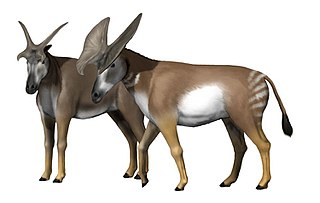
Prolibytherium is an extinct genus of prolibytheriid artiodactyl ungulate native to Middle Miocene North Africa and Pakistan, from around 16.9 to 15.97 million years ago. Fossils of Prolibytherium were found in the Marada Formation of Libya, Vihowa Formation of Pakistan, and the Moghara Formation of Egypt.
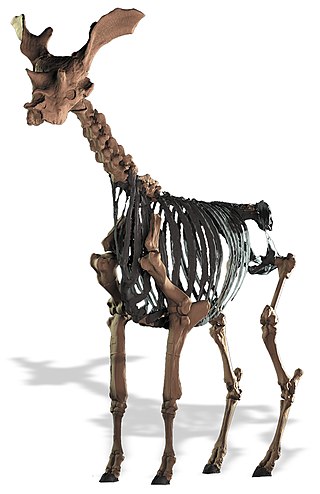
Sivatherium is an extinct genus of giraffids that ranged throughout Africa to the Indian subcontinent. The species Sivatherium giganteum is, by weight, one of the largest giraffids known, and also one of the largest ruminants of all time.

Ptolemaiida is a taxon of wolf-sized afrothere mammals that lived in northern and eastern Africa during the Paleogene. The oldest fossils are from the latest Eocene strata of the Jebel Qatrani Formation, near the Fayum oasis in Egypt. A tooth is known from an Oligocene-aged stratum in Angola, and Miocene specimens are known from Kenya and Uganda.

Kolponomos is an extinct genus of carnivoran mammal that existed in the Late Arikareean North American Land Mammal Age, early Miocene epoch, about 20 million years ago. It was likely a marine mammal. The genus was erected in 1960 by Ruben A. Stirton, a paleontologist at the University of California Museum of Paleontology, Berkeley, for the species K. clallamensis, on the basis of a partial skull and jaw found on the Olympic Peninsula. At the time, Stirton questionably assigned it to Procyonidae, its systematic position remained problematic until the discovery of more fossils including a nearly complete cranium from the original locality of K. clallamensis which helped identify it as part of the group from which pinnipeds evolved.
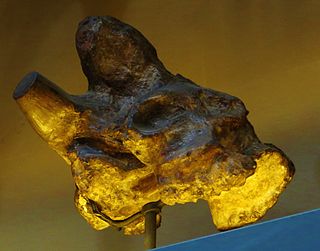
Bramatherium is an extinct genus of giraffids that ranged from India to Turkey in Asia. It is closely related to the larger Sivatherium.

Aulophyseter is an extinct genus of sperm whales from the Miocene formations of the west and east coasts of North America.

Brygmophyseter, known as the biting sperm whale, is an extinct genus of toothed whale in the sperm whale family with one species, B. shigensis. When it was first described in 1994, the species was placed in the genus Scaldicetus based on tooth morphology, but this was later revised in 1995. In 2006, it was classified into the genus Naganocetus, which is considered to be a junior synonym. The only known specimen, a nearly complete skeleton, was dated to be around 16–15 million years old. Brygmophyseter is thought to have been 6.5–7 meters (21–23 ft) long, and it probably had 11 or 12 teeth in the upper and lower jaws. Brygmophyseter is part of a group of macroraptorial sperm whales which tended to be apex predators using their large teeth to catch struggling prey such as whales. It had a spermaceti organ which was probably used for biosonar like in the modern sperm whale. The whale has made an appearance on The History Channel's TV series Jurassic Fight Club.
Hydaspitherium is an extinct genus of giraffid artiodactyls that lived during the Cenozoic era during the Miocene epoch to the Pliocene epoch in Pakistan. Giraffids are represented in the late Miocene epoch of the Siwaliks by large Sivatheriinae such as Sivatherium, Bramatherium, Helladotherium, and Hydaspitherium. Hydapitherium has been proposed to be synonymous with Bramatherium. H. megacephalum is restricted to the Dhok Pathan Formation in northern Pakistan.

Palaeogale is an extinct genus of carnivorous mammal known from the Late Eocene, Oligocene, and Early Miocene of North America, Europe, and Eastern Asia. A small carnivore often associated with the mustelids, Palaeogale might have been similar to living genets, civets, and linsangs.

Huilatherium is an extinct genus of leontiniid, a group of hoofed mammals belonging to the order Notoungulata, that comprises other South American ungulate families that evolved in parallel with some mammals of the Northern hemisphere. The leontiinids were a family of herbivorous species comprising medium to large browsers, with relatively short skulls and robust limbs, somewhat similar to their relatives, the best known toxodontids.

Hilarcotherium is an extinct genus of astrapotheriid mammals that lived in South America during the Middle Miocene (Laventan). The type species is H. castanedaii, found in sediments of the La Victoria Formation, part of the Honda Group in the department of Tolima in Colombia. In 2018, Carrillo et al. described a partial skull and mandible of a second species H. miyou from the Castilletes Formation in the Cocinetas Basin of northern Colombia, and estimated the body weight of the animal at 6,465 kilograms (14,253 lb).
Prosthennops is a genus of extinct peccaries that lived in North and Central America between the middle Miocene and lower Pliocene.
